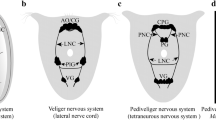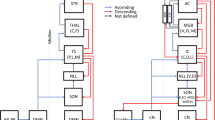Summary
Anurans such as the clawed toad Xenopus laevis offer a unique opportunity to study the ontogeny of descending pathways to the spinal cord. Their transition from aquatic limbless tadpole to juvenile toad occurs over a protracted period of time during which the animal is accessible for experimental studies. In Xenopus laevis tadpoles the development of descending pathways has been studied from early limb-bud stage on (stage 50) with the aid of HRP slow-release gels. In stage 50, cells of origin of descending supraspinal pathways were already present throughout the reticular formation (including the interstitial nucleus of the fasciculus longitudinalis medialis) and in the vestibular nuclear complex. Also the giant Mauthner cells project to the cord at this stage. A spinal projection from the anuran homologue of the nucleus ruber of higher vertebrates does not appear before stage 58, i.e. when the hindlimbs are used for locomotion. Hypothalamospinal projections appear for the first time at stage 57. These observations in Xenopus laevis tadpoles suggest that reticulospinal and vestibulospinal projections innervate spinal segments very early in development, whereas the anuran red nucleus projects spinalward definitely later in development.
Similar content being viewed by others
References
Billings SM (1972) Development of the Mauthner cell in Xenopus laevis: a light and electron microscopic study of the perikaryon. Z Anat Entwickl.-Gesch 136:168–191
Cabana T, Martin GF (1982) The origin of brain stem-spinal projections at different stages of development in the North American opossum. Dev Brain Res 2:163–168
Corvaja N, Grofová I (1972) Vestibulospinal projections in the toad. In: A Brodal and O Pompeiano, eds, Progress in brain research, Vol 37: Basic aspects of central vestibular mechanisms. Elsevier. Amsterdam: pp 297–307
Donkelaar HJ ten (1976) Descending pathways from the brain stem to the spinal cord in some reptiles. II. Course and site of termination. J Comp Neurol 167:443–464
Donkelaar HJ ten (1982) Organization of descending pathways to the spinal cord in amphibians and reptiles. In: HGJM Kuypers and GF Martin, eds, Descending pathways to the spinal cord. Elsevier. Amsterdam (in press)
Donkelaar HJ ten, Boer-van Huizen R de, Schouten FTM, Eggen SJH (1981) Cells of origin of descending pathways to the spinal cord in the clawed toad (Xenopus laevis). Neuroscience 6:2297–2312
Forehand CJ, Farel PB (1980) Development of the anuran spinal cord: ascending and descending systems. Soc Neurosci Abstr 6:847
Forehand CJ, Farel PB (1981) Metamorphosis and descending input to lumbar spinal cord: an investigation using two retrograde tracers in Rana catesbeiana. Soc Neurosci Abstr 7:71
Graham RC, Karnovsky MI (1966) Glomerular permeability. Ultrastructural cytochemical studies using peroxidase as protein tracers. J Exp Med 124:1123–1134
Grant P, Rubin E (1980) Ontogeny of the retina and optic nerve in Xenopus laevis. II. Ontogeny of the optic fiber pattern in the retina. J Comp Neurol 189:671–698
Griffin G, Watkins LR, Mayer DJ (1979) HRP pellets and slow-release gels: two new techniques for greater localization and sensitivity. Brain Res 168:595–601
Hughes A, Prestige MC (1967) Development of behaviour in the hindlimb of Xenopus laevis. J Zool (Lond) 152:347–359
Humbertson Jr AO, Martin GF (1979) The development of monoaminergic brainstem-spinal systems in the North American opossum. Anat Embryol 156:301–318
Katz MJ, Lasek RJ (1979) Substrate pathways which guide growing axons in Xenopus embryos. J Comp Neurol 183:817–832
Katz MJ, Lasek RJ (1981) Substrate pathways demonstrated by transplanted Mauthner axons. J Comp Neurol 195:627–641
Katz MJ, Lasek RJ, Nauta HJW (1980) Ontogeny of substrate pathways and the origin of the neural circuit pattern. Neuroscience 5:821–833
Kimmel CB, Model PG (1978) Developmental studies of the Mauthner cell. In: DS Faber and H Korn, eds, Neurobiology of the Mauthner Cell Raven Press: New York pp 183–220
Martin GF, Beals JH, Culberson JL, Dom R, Goode G, Humbertson Jr AO (1978) Observations on the development of brainstem-spinal systems in the North American opossum. J Comp Neurol 181:271–290
Martin GF, Cabana T, Culberson JL, Curry JJ, Tschismadia I (1980) The early development of corticobulbar and corticospinal systems. Studies using the North American opossum. Anat Embryol 161:197–213
Mesulam M-M (1978) Tetramethylbenzidine for horseradish peroxidase neurohistochemistry: a non-carcinogenic blue reactionproduct with superior sensitivity for visualizing neural afferents and efferents. J Histochem Cytochem 26:106–117
Moulton JM, Jurand A, Fox H (1968) A cytological study of Mauthner's cells in Xenopus laevis and Rana temporaria during metamorphosis. J Embryol Exp Morphol 19:415–431
Muntz L (1964) Neuro-muscular foundations of behaviour in embryonic and larval stages of the anuran, Xenopus laevis. PhD thesis, Bristol University, Bristol
Nieuwenhuys R, Opdam P (1976) Structure of the brain stem. In: R Llinás and W Precht, eds, Frog neurobiology. Springer: Berlin-Heidelberg pp 811–855
Nieuwkoop PD, Faber J (1967) Normal table of Xenopus laevis (Daudin). North Holland Publ Co., Amsterdam
Rovainen CM (1978) Müller cells, ‘Mauthner’ cells and other identified reticulospinal neurons in the lamprey. In: DS Faber and H Korn, eds, Neurobiology of the Mauthner Cell, Raven Press, New York, pp 245–269
Rovainen CM (1979) Neurobiology of lampreys. Physiol Rev 59:1007–1077
Singer M, Nordlander RH, Egar M (1979) Axonal guidance during embryogenesis and regeneration in the spinal cord of the newt: the blueprint hypothesis of neuronal pathway patterning. J Comp Neurol 185:1–22
Stefanelli A (1951) The Mauthnerian apparatus in the Ichthyopsida: its nature and function and correlated problems of neurohistogenesis. Quart Rev Biol 26:17–34
Taylor AC, Kollros JJ (1946) Stages in the normal development of Rana pipiens larvae. Anat Rec 94:7–23
Tohyama M, Maeda T, Shimizu N (1975) Comparative anatomy of the locus coeruleus. II. Organization and projection of the catecholamine containing neurons in the upper rhombencephalon of the frog, Rana catesbeiana. J Hirnforsch 16:81–89
Udin SB (1981) Development of the nucleus isthmi in Xenopus laevis. Soc Neurosci Abstr 7:406
Whiting HP (1957) Mauthner neurones in young larval lampreys. Quart J Micr Sci 98:163–178
Yamamoto K, Tohyama M, Shimizu N (1977) Comparative anatomy of the topography of the catecholamine containing neuron systems in the brain stem from birds to teleosts. J Hirnforsch 18:229–240
Author information
Authors and Affiliations
Rights and permissions
About this article
Cite this article
ten Donkelaar, H.J., de Boer-van Huizen, R. Observations on the development of descending pathways from the brain stem to the spinal cord in the clawed toad Xenopus laevis . Anat Embryol 163, 461–473 (1982). https://doi.org/10.1007/BF00305559
Accepted:
Issue Date:
DOI: https://doi.org/10.1007/BF00305559




